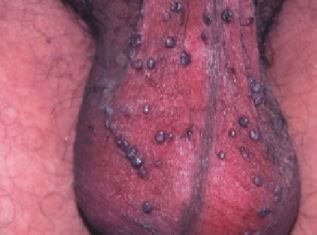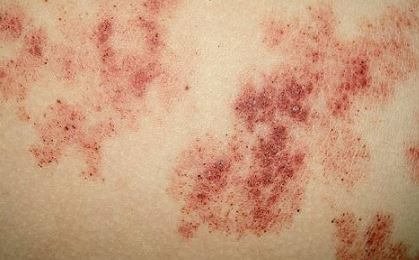What is Angiokeratoma?
Angiokeratoma is a non cancerous skin condition that affects upper layers of your skin and blood vessels below it. It is characterized by raised regions of your skin called papules, thickened epidermis and enlarged blood vessels.

The enlarged blood vessels may be due to elevated pressure in your veins caused by any of the following:
- Tumors of urinary tract
- Pregnancy
- Thrombophlebitis
- Hernia
Although these conditions lead to dilated blood vessels, most of them do not promote angiokeratoma.
Forms of Angiokeratoma
There are several forms of angiokeratoma grouped according to places they affect on your body. They include:
Angiokeratoma of Fordyce

This form of angiokeratoma affects scrotum in male and vulva in female. Other areas this condition may affect include penis shaft in men, outer genital folds or labia major, lower abdomen and inner thigh in women.
The lesions may appear as large or small and black, red or blue in color. This condition may affect single or several lesions on scrotum, shaft of your penis and vulva. Angiokeratoma of fordyce may not manifest any symptoms but when the lesions on those areas are scratched or after having sex, they easily bleed.
Angiokeratoma circumsciptum

Angiokeratoma circumsciptum is also known as verrucous vascular malformation. It is a skin disorder which affects a group of lesions on a small area of your body. This condition usually affects extreme areas of your body and is characterized by dark lesions after a certain period.
Angiokeratoma circumsciptum may be congenital and people usually call these lesions as birthmarks. This form of angiokeratoma affects the development of blood vessels below the epidermis.
Angiokeratoma corporis diffusum

Angiokeratoma corporis diffusum is also called Fabrys syndrome. Fabrys syndrome is rare type of angiokeratoma.
This condition is hereditary; it is passed from parent to child after inheriting mutated genes for this disease. Angiokeratoma corporis diffusum affects men severely than women.
This disorder affects your whole body and lesions in your groins areas and lower trunk are more affected. Angiokeratoma corporis diffusum is a severe form of angiokeratoma.
A person with this condition may experience failure of some organs in the body to perform properly, which may lead to serious health problems. Other complications of this condition include people feeling pain in their hands, arthritis, stroke and loss of vision, which may lead to blindness.
Sporadic angiokeratoma
Sporadic angiokeratoma is a type of angiokeratoma that affect single lesions on your skin. The lesions are found in lower edges of your skin and appear as small elevations that are black or blue in color. This condition is more prevalent in people above the age of 40 years.
Mibellis angiokeratoma
This is a type of angiokeratoma that affects your fingers and toes.
Causes
The exact cause of many types of angiokeratoma is not known apart from angiokeratoma corporis diffusum (Fabrys syndrome) which is caused by genetic factors.
Angiokeratoma corporis diffusum (Fabrys syndrome) is genetic disorder. It occurs when a recessive gene called X-chromosome, which lack alpha-galactosidase enzyme is passed to the child.

This enzyme is responsible for metabolizing lipids. Lack of this enzyme causes glycosphingolipids to accumulate in your endothelium and other regions of your body such as heart, nervous system and kidney.
Symptoms
People affected with this condition usually manifest symptoms such as small and enlarged blood vessels in areas near their skin and mucous membrane.
They can occur anywhere on the skin of the affected people but they are usually seen on the chin, face, and certain regions of the nose.
Affected people also have a thickened epidermis, which may produce warts on the mouth especially on the mucosal layers and skin.
Other symptoms of this condition include:
- In young patients, the lesions are red while older patients may have lesions that are dark.
- Bleeding is also common especially in the lesion in the scrotum and labia after sex or pregnancy.
People with angiokeratoma corporis diffusum (Fabrys syndrome) especially men may have the following serious symptoms:
- They may feel acute pains in feet and hands.
- May also experience heart and kidney failure
- In some cases, your nervous system is affected.
Diagnosis
The diagnosis will begin with a physical exanimation of the affected skin by your doctor. Your doctor uses a dermatoscope to find out the nature of the lesions on your body.
Your doctor will perform other tests such as biopsy of unusual growth on your skin to confirm the diagnosis of this disorder and rule out other skin diseases.
For people with angiokeratoma corporis diffusum (Fabrys syndrome) condition, your doctor may take a sample of your blood and analyze it to determine the level of alpha-galactosidase in your blood. Also, your doctor may carry out a kidney biopsy to measure the quantity of intraglomerular lipids in body.
Treatment
Pain caused by lesions can be lessened through the following treatment methods:
Surgical excision
In this procedure, your doctor uses a scalpel or a sharp razor to remove affected lesion and graft your skin.
Laser therapy
Low level or cold laser therapy may be used to treat the damaged tissues on your skin. This procedure utilizes light of different wavelengths to promote healing. Your doctor places the laser on the affected areas of your skin for some minutes or seconds depending on the area of your skin that is damaged.
The laser emits light that passes via the layers of your skin and reaches the target area, which is affected. The cells in the tissue absorb the light which eventually reduces pain and corrects the injured tissue in your body.
Cryotherapy
This procedure involves the use of very cold temperatures to eliminate the affected tissue. In cryotherapy, your doctor places a tube with liquid consisting of nitrogen or gas such as argon near the injured area of your skin. The low temperatures inactivate the damaged tissues hence reduce pain.
Electrocautery
This procedure involves the use of electric current to eliminate the affected tissues on your skin. Your doctor heats a metal probe using electric current and places it on the affected areas on your skin and destroys the damaged tissue.
Reference List
- Angiokeratoma. http://heydoctor.org/angiokeratoma.html
- https://www.dermnetnz.org/topics/angiokeratomas
- http://www.primehealthchannel.com/angiokeratoma.html
- Surgical Excision (Shave Excision of Skin Lesion). http://www.healthline.com/health/surgical-excision#overview1
- Cryotherapy. http://www.medicinenet.com/cryotherapy/article.htm
- Laser therapy. http://www.spine-health.com/treatment/pain-management/cold-laser-therapy-pain-management-treatment
Similar Posts:
- Syringoma – Treatment, Removal, Pictures, Causes, Surgery, Prevention
- Sebaceous Adenoma – Causes, Symptoms, Treatment, Pictures
- Trichoepithelioma – Pictures, Treatment, Symptoms, Causes
- Angiolipoma
- Squamous Cell Carcinoma in Situ – Pictures, Treatment, Symptoms
- Langerhans Cell Histiocytosis
- Pilomatricoma – Treatment, Pictures, Symptoms, Causes, Prognosis






Leave a Reply